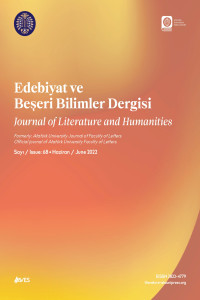TECELLİ SERCAN SİRMANIN “İYİYİ VE KÖTÜYÜ BİLME AĞACI” ROMANININ PROBLEMATİKASI, JANR XÜSUSİYYƏTLƏRİ, KOMPOZİSİYASI VƏ BƏDİİ OBRAZLARI
Türk edebiyatı, roman türü, savaş, tarihi gerçekler, karakterler, tarihsel bellek, tür özellikleri.
Problems, Genre Features, Composition and Artistic Images of Tecelli Sercan Sirman's Novel “The Tree of Knowing Good and Evil”
Turkish literature, novel genre, war, artistic images, symbols, historical memory, genre features,
___
- Batuk, Cengiz (2006). “Âdem ve Havva’nın Kitabı: Eski Ahit Apokrifasında Âdem ve Havva’nın Hayatı”. Hitit Üniversitesi İlahiyat Fakültesi Dergisi, 2 (10).
- Şəmsizadə, Nizaməddin. (2018) Türkçülük və epos mədəniyyəti //Ədəbiyyat qəzeti–17 mart. http://www.anl.az/down/meqale/edebiyyat/2018/mart/583520.htm. Erişim Tarihi: 02.07.2021.
- Şərifova, Salidə. (2015). Çağdaş Azərbaycan postmodern romanı. Bakı, “Elm və təhsil”.
- Tecelli Sercan Sırma. (2018). Yaxşını və pisi bilmək ağacı. Ədəbiyyat qəzeti – 4 avqust. // http://www.anl.az/down/meqale/edebiyyat/2018/avqust/602177.htm. Erişim Tarihi: 02.07.2021
- Tecelli, Sercan Sirman. (2018). İyiyi ve Kötüyü Bilme Ağacı. İletişim Yayıncılık A.S. (1. Basım). İstanbul.
- Tekvin: 2/5- 25; McCurdy, “Adam”, s.174; Gürkan, “Yahudi ve İslam Kutsal Metinlerinde İnsanın Yaratılışı...”, s.6- 7; Bolay, s.358. // Bax. Dinlerin insana verdiği değer (yahudilik, hıristiyanlık ve islam örneği), Ankara, 2013. file:///C:/Users/MSH/Desktop/T_C_ANKARA_UNIVERSITESI_SOSYAL_BILIMLER.pdf. (Elektron sürüm). Erişim Tarihi: 02.07.2021.
- Türkiye Diyanet Vakfı İslam Ansiklopedisi, ‘Adem’ maddesi // https://islamansiklopedisi.org.tr/adem – peygamber. Erişim Tarihi: 02.07.2021.
- Yayın Aralığı: Yılda 2 Sayı
- Başlangıç: 1970
- Yayıncı: Atatürk Üniversitesi
SİMURG İLE İLGİLİ AÇIKLAYICI BİR METİN: DER BEYÂN-I AHVÂL-İ SÎMURG-I ‘ANKÂ
ÇOCUK OYUNLARININ BİLİŞSEL GELİŞİME ETKİLERİ: “ESKİ MİNDER” VE “DEVE-CÜCE” ÖRNEKLERİ
DÂSTÂN-I EJDERHÂ’NIN PARİS BIBLIOTHEQUE NATIONA-LE (Turc 396) NÜSHASI ÜZERİNE BİR İNCELEME
EGEMEN SÖYLEM KARŞISINDA KADIN: ERKEK HEGEMONYASINDA İKİNCİ CİNS
13.-15. YÜZYILLARDA AZAK DENİZİ’NDE BALIK VE HAVYAR TİCARETİ
SADRİ ERTEM’İN ÖYKÜLERİNDE TEMA
“EPİK BİR RESİM KİTABI” OLAN BENİM ADIM KIRMIZI’DA MANZARANIN KEŞFİ
